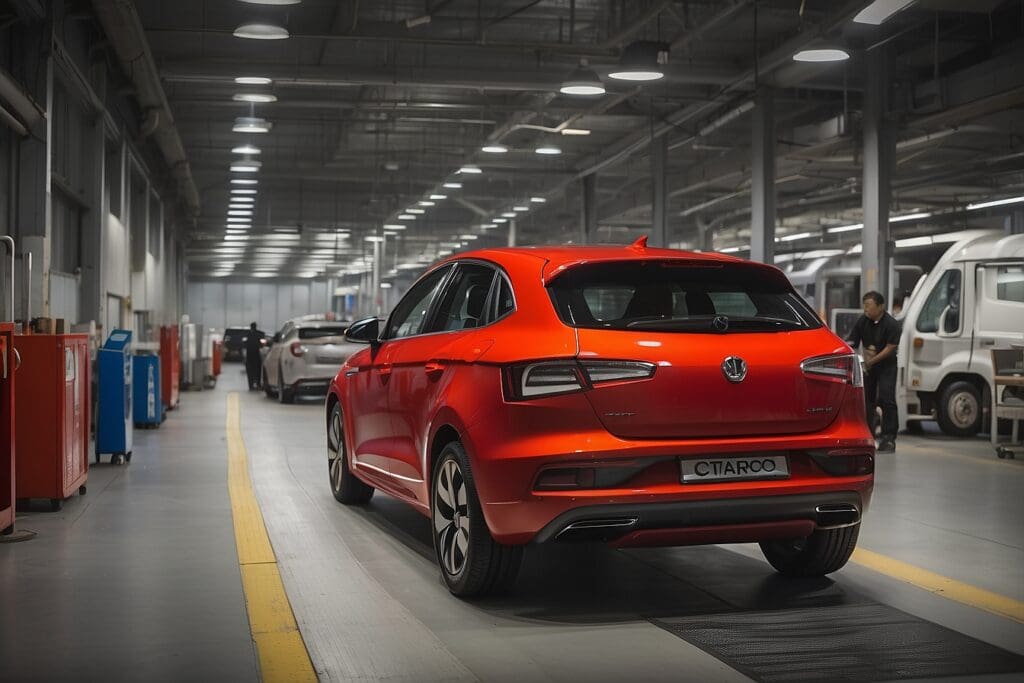We all yearn for that breath of fresh air and a planet that thrives in robust health, but diving into the intricate maze of automotive emission regulations can leave one feeling quite muddled.
Fear not; we are shoulder to shoulder with you, resolute in our quest to demystify the latest environmental mandates influencing our motors and overall wellbeing. In this friendly natter, we shall delve into the recent shifts within emissions protocol—celebrating innovative breakthroughs and evolving policies designed to diminish those pesky greenhouse gases.
Stick around for an enlightening chinwag on how we can all contribute to a brighter, more verdant journey down our roads ahead.
Key Takeaways
- Automotive CO2 emissions have reached a record low due to advancements in technology, while fuel economy hits an all-time high.
- The market shift towards SUVs is being addressed by manufacturers with a focus on developing more fuel-efficient and environmentally friendly models to meet regulatory standards.
- Innovations in engine design, alternative fuels, and advanced emission control technologies are crucial for reducing pollutants from internal combustion engines.
- To comply with the Light – Duty GHG Program, automakers can use credits earned by exceeding standards or buy them to balance overall fleet emissions.
- Proposed regulations advocate for stricter reductions in vehicle emissions and improvements in fuels, lubricants, and testing methods that require industry support.
Overview of EPA Automotive Trends Report

The EPA Automotive Trends Report highlights record low CO2 emissions and high fuel economy, despite the market shift towards SUVs. It also showcases the advancements in automotive technology that have contributed to these improvements.
Record low CO2 emissions
We’ve witnessed a significant milestone with CO2 emissions hitting record lows. This is a testament to the strides we are making in automotive technology, pushing us towards greener and cleaner vehicles.
As we embrace these innovations, our cars now emit fewer carbon dioxide gases than ever before, which is crucial in the fight against global warming.
Our journey doesn’t end here; this achievement fuels our commitment to environmental protection. We continue to champion fuel efficiency standards while supporting advancements in emission control technologies.
Together, we’re not just driving on roads – we’re paving the way towards a sustainable future for all.
Record high fuel economy in automotive emission regulations
Following the record low CO2 emissions, we observe a significant achievement in the automotive industry – record high fuel economy. This milestone is an indicator of the positive strides being made towards more sustainable and eco-friendly transportation.
The advancements in automotive technology are driving this progress, with manufacturers investing in more efficient engines and lightweight materials to improve fuel efficiency. As consumers continue to demand vehicles that have a reduced impact on the environment, automakers are responding by innovating and producing cars with higher miles per gallon ratings.
Elevated fuel economy standards not only benefit the environment but also contribute to cost savings for drivers. By using less fuel, vehicles with high fuel economy help to reduce greenhouse gas emissions and dependence on fossil fuels, aligning with efforts to combat climate change.
Market shifts towards SUVs
Transitioning from the impressive progress in fuel economy, it is notable that market shifts towards SUVs have been observed. The automotive industry has seen a significant trend towards consumer preference for SUVs over traditional passenger cars.
This shift has prompted manufacturers to focus on developing more fuel-efficient and environmentally friendly SUV models, as they strive to meet regulatory standards and cater to the growing demand for cleaner vehicles.
Furthermore, this shift highlights the importance of continued innovation in automotive technology to ensure that SUVs are equipped with efficient emissions control measures, contributing to overall reductions in vehicle emissions and air pollution.
Improvements in technology
Automotive technology is rapidly advancing, with innovations aimed at reducing vehicle emissions playing a pivotal role. Advancements in engine design, such as turbocharging and direct fuel injection, contribute to improved fuel economy and reduced CO2 emissions.
Additionally, the development of hybrid and electric vehicles has made significant strides in lowering overall carbon emissions from the automotive sector. Furthermore, the integration of lightweight materials and aerodynamic designs enhances vehicle efficiency, aligning with global warming regulations and clean air standards.
The implementation of cutting-edge emission control technologies not only reduces harmful pollutants but also drives continuous improvement in vehicle pollution standards. Advanced exhaust after-treatment systems effectively mitigate emissions from internal combustion engines.
Compliance with Light-Duty GHG Program
We will discuss the use of credits and the need for stronger regulations to ensure compliance with the Light-Duty GHG Program. Read on to learn more about the current trends in reducing automotive emissions.
Use of credits
To comply with the Light-Duty GHG Programme, automotive manufacturers can use credits as part of their compliance strategy. Here is a breakdown of how this system works:
- Credits for improvements beyond compliance: Manufacturers can earn credits for exceeding the required fuel economy standards, which can then be used to offset shortfalls in other areas.
- Flexibility in meeting standards: The credit system offers flexibility for manufacturers to meet emissions targets by allowing them to make up any deficits through reducing emissions in another area or purchasing credits from others who have exceeded their requirements.
- Balancing emissions across the fleet: This approach incentivises overall fleet-wide emissions reductions rather than focusing solely on each individual vehicle model, ensuring a more holistic approach to compliance.
- Encouraging innovation: By providing an avenue for earning and trading credits, manufacturers are encouraged to innovate and invest in new technologies that will ultimately lead to cleaner vehicles and reduced emissions.
Need for stronger regulations
To ensure cleaner air and reduce the environmental impact of vehicles, we must advocate for stronger regulations. These regulations should focus on lowering carbon dioxide emissions and increasing fuel efficiency in both passenger cars and trucks.
It is essential to push for more stringent standards that challenge the automotive industry to innovate and adopt clean vehicle technologies. Additionally, regulatory bodies need to consider all aspects, including fuels, lubricants, and testing methods when implementing these regulations.
Collaboration between regulators and industry players is crucial to support the development and implementation of effective emission control measures.
Trends in Reducing Emissions from Internal Combustion Engines
We will discuss the latest trends in reducing emissions from internal combustion engines, including an overview of the 6th International Exhaust Emissions Symposium and the technical sessions that were held.
Don’t miss out on this important information about how the automotive industry is working to reduce harmful emissions. Read more to stay informed about these crucial developments!
Overview of 6th International Exhaust Emissions Symposium
The 6th International Exhaust Emissions Symposium showcased cutting-edge advancements in emission control technologies. Leading experts and industry professionals gathered to exchange insights on improving air quality by reducing vehicle emissions.
The symposium featured technical sessions focusing on innovative solutions for enhancing the efficiency of internal combustion engines, as well as exploring new approaches to address the environmental impact of automotive emissions.
During the symposium, discussions centered around the development of cleaner fuels, lubricants, and test methods that play a crucial role in achieving stringent emission standards.
Technical sessions
After the overview of the 6th International Exhaust Emissions Symposium, let’s delve into the technical sessions. The symposium featured a range of technical sessions that explored various aspects of emissions control and reduction in internal combustion engines. The discussions delved into advancements in exhaust after-treatment technologies, including catalytic converters and particulate filters, as well as innovative solutions for reducing nitrogen oxides (NOx) and hydrocarbon emissions. Moreover, there were presentations on the development of cleaner-burning fuels and lubricants to complement emission control measures. Additionally, experts shared insights on the latest advancements in testing methods and instrumentation for accurately measuring vehicle emissions in real-world driving conditions. Lastly, industry professionals discussed collaborative efforts aimed at implementing effective emission control measures across the automotive sector.
Impact and Implications of EPA’s New Pollution Standards
The proposed regulations for passenger cars and trucks include stringent standards for reducing emissions, as well as considerations for fuels, lubricants, and test methods. It is crucial for the automotive industry to support and collaborate in order to meet these new pollution standards.
Discover more about the latest trends in automotive emission regulations by reading our full blog post.
Proposed regulations for passenger cars and trucks
Proposed regulations for passenger cars and trucks aim to set stringent standards for reducing emissions, in turn promoting cleaner air. The focus is on developing solutions that reduce vehicle CO2 emissions and improve fuel efficiency.
These regulations also consider other factors such as fuels, lubricants, and test methods, highlighting the need for industry support and collaboration to achieve these clean vehicle standards.
The proposed regulations for passenger cars and trucks are crucial in addressing environmental concerns related to vehicle emissions. They require a collective effort from the automotive industry to embrace cleaner technologies and practices while ensuring compliance with the new pollution standards.
Stringent standards for reducing emissions
Automakers are implementing stringent standards to reduce emissions from vehicles, focusing on cutting CO2 and other pollutants. These measures aim to improve air quality and combat climate change by enhancing fuel efficiency and promoting cleaner technologies in the automotive industry.
The push for stricter emission regulations aligns with the growing demand for more sustainable transportation solutions, emphasising a collective effort towards environmental conservation.
The adoption of these stringent standards not only benefits the environment but also encourages innovation in vehicle design and engineering. As regulations continue to evolve, it becomes imperative for industry stakeholders to collaborate in driving forward technological advancements that support cleaner air and reduced carbon emissions.
Other factors to consider: fuels, lubricants, and test methods
When considering automotive emission regulations, it’s crucial to take into account other factors such as fuels, lubricants, and test methods. These aspects play a significant role in reducing emissions and promoting environmental conservation.
- Fuels: The type of fuel used in vehicles has a direct impact on emissions. Cleaner-burning fuels and alternative energy sources such as biofuels contribute to lower CO2 emissions and improved air quality.
- Lubricants: High-quality lubricants can enhance engine efficiency and reduce emissions by minimising friction within the engine components. Advanced lubricants also contribute to extended engine life and reduced environmental impact.
- Test Methods: Accurate testing methods are essential for evaluating the effectiveness of emission control measures. Rigorous and standardised testing procedures ensure compliance with regulations and provide valuable data for continuous improvement.
- Impact Assessment: Regular assessments of the impact of fuels, lubricants, and testing methods on emissions are necessary to refine regulatory standards and maintain progress towards cleaner automotive technologies.
- Collaboration: Close collaboration between industry stakeholders, regulatory bodies, and environmental organisations is vital for advancing research and development of innovative solutions that address emissions from vehicles comprehensively.
- Consumer Awareness: Educating consumers about the importance of using eco-friendly fuels, sustainable lubricants, and adhering to emission standards plays a critical role in creating a collective effort towards preserving the environment.
- Technological Advancements: Continued research into advanced fuel formulations, eco-friendly lubricants, and enhanced testing methodologies is pivotal for achieving long-term sustainability goals in vehicle emissions reduction.
Need for industry support and collaboration

The automotive industry requires strong collaboration and support to successfully meet the stringent emission standards and fuel efficiency regulations. Industry players must come together to invest in research and development, as well as share best practices to accelerate the adoption of advanced technologies that reduce vehicle emissions.
By working collectively, the industry can drive innovation in fuels, lubricants, and testing methods, ultimately achieving cleaner air and a more sustainable future for all.
To uphold these high standards for emissions control measures, the automotive industry needs a united front with continuous backing from both manufacturers and regulators. Through this collaborative approach, we can ensure that vehicles are not only efficient but also environmentally friendly while meeting compliance with clean air regulations.
Conclusion
In conclusion, automotive emission regulations continue to evolve with a focus on reducing CO2 and improving fuel economy. The industry is shifting towards SUVs while embracing technological advancements to comply with light-duty GHG programs.
Efforts in reducing emissions from internal combustion engines are highlighted at international symposiums. The impact of EPA’s new pollution standards calls for stringent regulations and industry collaboration to achieve cleaner transportation.
FAQs
1. What are vehicle emissions regulations?
Vehicle emissions regulations are rules set for the automotive industry to control the amount of polluting gases, like CO emissions, that cars release into the environment.
2. Why is automotive fuel efficiency important in emission regulations?
Automotive fuel efficiency is crucial because it reduces how much fuel a car uses and decreases harmful emissions, helping to meet strict vehicle emission control measures.
3. How do new trends affect the automotive industry in terms of regulations?
New trends in automotive emission regulations push car manufacturers to adopt cleaner technology and produce vehicles that emit fewer pollutants, aligning with tighter industry standards.
4. Can I expect more changes in vehicle emission regulations soon?
Yes, you can expect ongoing updates as technological advancements continue driving stricter controls over vehicle fuel efficiency and efforts to reduce environmental impact within the automotive sector.





